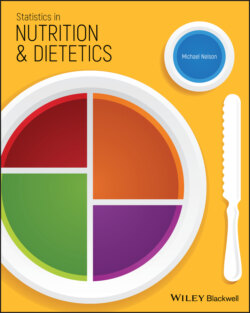Читать книгу Statistics in Nutrition and Dietetics - Michael Nelson - Страница 14
ОглавлениеPART 1 SETTING THE STATISTICAL SCENE
Learning Objectives
You should be reading this textbook because you want to:
Learn how to design and analyze research projects
Develop the skills to communicate the results and inferences from research
Learn to evaluate the scientific literature
The ideas upon which these skills are founded – an understanding of the scientific method, an introduction to different models of scientific investigation, and the statistical tools to understand the significance of research findings – form the core of this book. Practical, worked examples are used throughout to facilitate an understanding of how research methods and statistics operate at their most fundamental level. Exercises are given at the end of each chapter (with detailed, worked solutions at the end of the book, with more examples and solutions online) to enable you to learn for yourself how to apply and interpret the statistical tools.
Approaching the Statistician
I have a grown‐up son and a grand‐daughter, age 6 and ¾. They are both very artistic. When I asked them to put their heads together and draw a picture of a statistician by way of illustration for this book, this is what they came up with (Figure 1):
‘What’s that!’ I cried. ‘He’s hideous!’
‘Well’, they explained, ‘the eyes are for peering into the dark recesses of the student’s incompetence, the teeth for tearing apart their feeble attempts at research design and statistical analysis and reporting, and the tongue for lashing them for being so stupid’.
‘No, no, no’, I said. ‘Statisticians are not like that’. So here was their second attempt (Figure 2):
‘That’s better’, I said.
They interpreted the new drawing. ‘Statisticians may appear a bit monstrous, but really they’re quite cuddly. You just have to become familiar with their language, and then they will be very friendly and helpful. Don’t be put off if some of them look a bit flabby or scaly. This one can also recommend a great dentist and a very creative hair‐stylist’.
FIGURE 1 A SCARY STATISTICIAN.
Using Computers
Because computers can do in a few seconds what takes minutes or hours by hand, the use of computer statistical software is recommended and encouraged. However, computers are inherently stupid, and if they are not given the correct instructions, they will display on screen a result which is meaningless in relation to the problem being solved. It is vitally important, therefore, to learn how to enter relevant data and instructions correctly and interpret computer output to ensure that the computer has done what you wanted it to do. Throughout the book, examples of output from SPSS are used to show how computers can display the results of analyses, and how these results can be interpreted.
This text is unashamedly oriented toward experimental science and the idea that things can be measured objectively or in controlled circumstances. This is a different emphasis from books which are oriented toward qualitative science, where descriptions of how people feel or perceive themselves or others are of greater importance than quantitative measures such as nutrient intake or blood pressure. Both approaches have their strengths and weaknesses, and it is not my intention to argue their relative merits here.
FIGURE 2 A FRIENDLY STATISTICIAN.
The examples are taken mainly from studies in nutrition and dietetics. The aim is to provide material relevant to the reader’s working life, be they students, researchers, tutors, or practicing nutrition scientists or dietitians.
